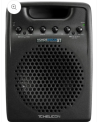chillybilly
Member
We're all familiar with the musical type of feedback that (usually) comes from a cranked amp. Picking two examples from memory:
-Don't Let Him Go (REO Speedwagon) - chords that lead into the verse
-More Than A Feeling (Boston) - the lead part between verse & chorus when a held note becomes a 'feedback harmonic'
Obviously there are multiple elements from the guitar body's own resonance to the pickups to the amp to the speaker cone to the gain level to any pedals in use. And then there is the angle at which one faces toward or away from the amp/cab. And it seems the tubes play a role too.
I have seen feedback generator pedals like the Boss FB2 but haven't personally used them in traditional tube rig.
I'm curious about obtaining similar from the FM9T. I have numerous gain-y presets built, usually with a JCM800 or Friedman. I've never really had a need or use for the super-high-gain stuff like Engl. I'll typically put a HeartPedal/Zen Master/Chiron in front (footswitchable).
At club gig volume through FRFR I'm getting SOME of that feedback but it's less than and dissimilar to what a tube amp at similar SPL might generate.
In terms of A/B comparison playing chords etc normally the sound is lifelike, quality & convincing with the FM9T but when I want to conjure some of those ghostly overtones from sustaining a note - which in turn causes the note to sustain more - I'm falling short of the mark.
It's possible I'm asking for that which cannot be created artificially due to the properties and physics described above but I'm still curious about others' methods or experiences.
-Don't Let Him Go (REO Speedwagon) - chords that lead into the verse
-More Than A Feeling (Boston) - the lead part between verse & chorus when a held note becomes a 'feedback harmonic'
Obviously there are multiple elements from the guitar body's own resonance to the pickups to the amp to the speaker cone to the gain level to any pedals in use. And then there is the angle at which one faces toward or away from the amp/cab. And it seems the tubes play a role too.
I have seen feedback generator pedals like the Boss FB2 but haven't personally used them in traditional tube rig.
I'm curious about obtaining similar from the FM9T. I have numerous gain-y presets built, usually with a JCM800 or Friedman. I've never really had a need or use for the super-high-gain stuff like Engl. I'll typically put a HeartPedal/Zen Master/Chiron in front (footswitchable).
At club gig volume through FRFR I'm getting SOME of that feedback but it's less than and dissimilar to what a tube amp at similar SPL might generate.
In terms of A/B comparison playing chords etc normally the sound is lifelike, quality & convincing with the FM9T but when I want to conjure some of those ghostly overtones from sustaining a note - which in turn causes the note to sustain more - I'm falling short of the mark.
It's possible I'm asking for that which cannot be created artificially due to the properties and physics described above but I'm still curious about others' methods or experiences.


